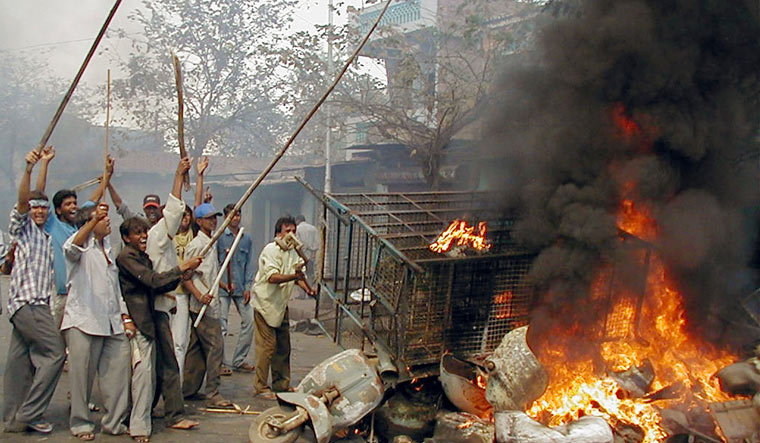
2002 Gujarat Riots: Causes, Consequences, and Narendra Modi’s Role
Introduction
The 2002 Gujarat riots were a series of violent incidents that occurred in the Indian state of Gujarat between February and May 2002. The violence was triggered by the Godhra train burning incident on February 27, 2002, where 59 Hindu pilgrims, mostly kar sevaks returning from Ayodhya, were killed when the Sabarmati Express was set on fire. This tragic event sparked widespread communal riots across Gujarat, leading to over 1,000 deaths, the majority of whom were Muslims. The riots remain one of the most controversial chapters in India’s history, with ongoing debates regarding government response and accountability.
Godhra Train Burning Incident: The Spark
On February 27, 2002, the Sabarmati Express carrying Hindu pilgrims from Ayodhya was attacked near Godhra station. The fire resulted in the deaths of 59 people, igniting Hindu-Muslim tensions across Gujarat. This incident acted as the catalyst for the widespread communal violence that ensued in the following months.
The Gujarat Riots: Communal Violence Across the State
Following the Godhra train burning, mass violence erupted across Gujarat, leading to widespread destruction, loss of life, and displacement. The violence primarily impacted the Muslim community, with reports of mob lynchings, arson, and sexual violence. Several regions, including Ahmedabad, Vadodara, and rural Gujarat, witnessed brutal communal clashes. The riots lasted for several months, causing significant social and political turmoil in India.
Narendra Modi’s Role and Controversy
At the time of the riots, Narendra Modi was the Chief Minister of Gujarat. His role in handling the violence has been a subject of intense debate and scrutiny. The Modi government faced accusations of inaction, with critics alleging that the administration did not do enough to prevent the riots and, in some cases, was complicit in the violence.
Allegations of Government Inaction
- Criticism from Human Rights Groups: Several human rights organizations and activists accused the Gujarat government of failing to control the violence.
- Eyewitness Accounts: Some reports suggested that police forces were slow to respond, and in some cases, were allegedly instructed not to intervene effectively.
- Political and Media Reactions: The riots drew severe condemnation from international media, political leaders, and activists, questioning the Gujarat government’s response.
Supreme Court & SIT Investigation
In response to legal petitions and allegations, the Supreme Court of India ordered a Special Investigation Team (SIT) to probe Modi’s role in the Gujarat riots. After a detailed investigation, the SIT report (2012) gave Narendra Modi a clean chit, stating that there was no prosecutable evidence against him.
- The SIT findings were upheld by the Supreme Court, concluding that Modi had no direct role in orchestrating or allowing the violence.
- Despite the legal exoneration, critics and activists continued to allege that justice had not been served, keeping the debate alive.
Political Fallout and International Reactions
The 2002 Gujarat riots had significant political and diplomatic consequences for Narendra Modi:
- International Condemnation: The U.S. denied Modi a visa in 2005 under the International Religious Freedom Act, citing concerns over his alleged role in the riots.
- Domestic Political Impact: Despite the controversy, Modi’s popularity in India remained strong. He won subsequent elections in Gujarat, cementing his position as a powerful political leader.
- Rise to Prime Ministership: Modi’s governance model and development policies helped him overcome the 2002 controversy, leading to his victory in the 2014 Indian general elections, where he became Prime Minister of India.
Activists and Legal Pursuits: The Teesta Setalvad Factor
Several activists and victims’ families continued to seek justice for the riot victims. Prominent among them was Teesta Setalvad, a well-known human rights activist who fought legal battles on behalf of riot victims.
- Legal Cases and Allegations: Setalvad and other activists pushed for legal action against officials and political leaders allegedly involved in the riots.
- Challenges and Setbacks: Many legal petitions faced setbacks in court, with several cases being dismissed due to lack of concrete evidence.
- Government Response: The Gujarat and central governments have maintained that the judiciary has ruled fairly, and all those responsible have been brought to justice.
Conclusion
The 2002 Gujarat riots remain one of the most debated events in modern Indian history. While the violence led to tragic loss of life and long-term communal tensions, the political trajectory of Narendra Modi saw a dramatic rise despite the controversies. The SIT investigation cleared Modi of any direct involvement, but activists and political opponents continue to question the handling of the riots. The events of 2002 still influence India’s socio-political discourse, reflecting the complexities of communal harmony, governance, and justice in the country.